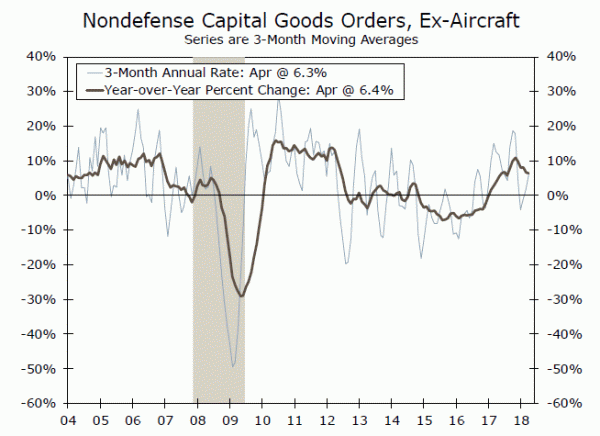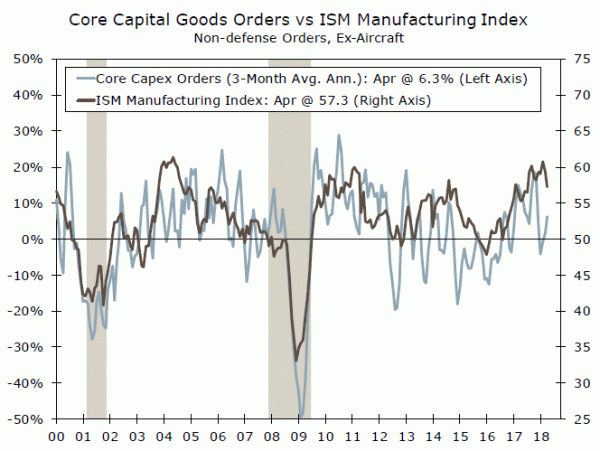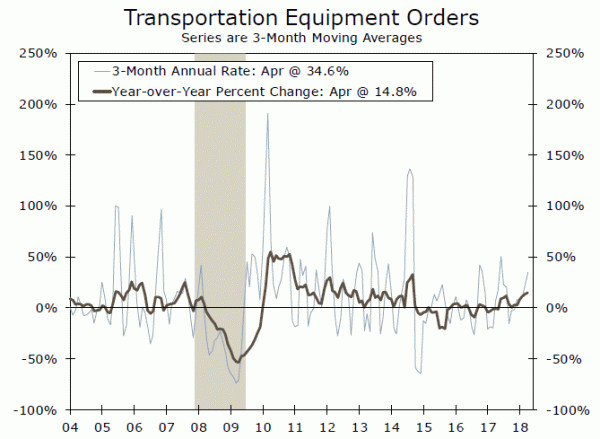Durable goods orders fell 1.7 percent in April on a drop in aircraft. Transportation orders have been picking up on net, however, while core capital goods orders are also improving.
Beyond April’s Drop in Aircraft, Signs of Strengthening Orders After two months of solid gains, durable goods orders reversed course in April. Orders fell 1.7 percent, which was a bit worse than consensus expectations for a 1.3 percent pullback and more closely in line with our forecast for a 2.0 percent drop.
Per usual, the sharp move over just one month can be traced to aircraft. Transportation orders fell 6.1 percent as aircraft orders plunged nearly 30 percent. New orders for motor vehicles and parts, on the other hand, notched a 1.8 percent gain, which was the sector’s seventh consecutive monthly increase.
While the volatility of transportation orders often leads us to focus on other sectors on a monthly basis, it is important to not lose sight of the forest from the trees. Through the month-to-month volatility, transportation has been a bright spot in investment spending of late. Year-to-date, transportation spending is up 9.0 percent compared to 7.3 percent ex-transportation. Unfilled orders for motor vehicles & parts are at record highs, while backlogs for nondefense aircraft have been rising over the past year and are only a touch below their 2014 high-water mark. Given the fairly long lead times of transportation orders—specifically aircraft orders—the sector should help underpin a decent rate of equipment spending in the coming quarters.
Ex-transportation, orders have gained some steam since the start of the year and were up 0.9 percent in April. Nondefense capital goods orders exaircraft, our preferred gauge of business spending, also look to be emerging from an early-year slump. Core orders rose 1.0 percent last month. Despite a half-point downward revision to March, core orders have improved to a 6.3 percent three-month average annualized pace. Orders for metals, machinery and electrical equipment have all strengthened since the start of the year. The pickup in core orders suggests equipment spending should continue to rise in Q2 despite nondefense capital goods shipments getting off to a rough start and declining 4.6 percent in April.
Meet in the Middle
More recent readings on the manufacturing sector suggest growth has held up through the second month of the quarter. Four of the regional Fed manufacturing PMIs have already been released for May, and all showed growth accelerating from April. Such broad-based improvement points to the nationally representative ISM manufacturing index also rising in May.
That, however, still leaves a fairly wide gap between the strength indicated by “soft” survey data and the “hard” numbers on orders. We expect to see some meeting in the middle. While business spending is not likely to grow at the booming rate indicated by the PMIs, we anticipate equipment spending will strengthen in the second quarter from the 4.7 percent clip registered in the first quarter.















